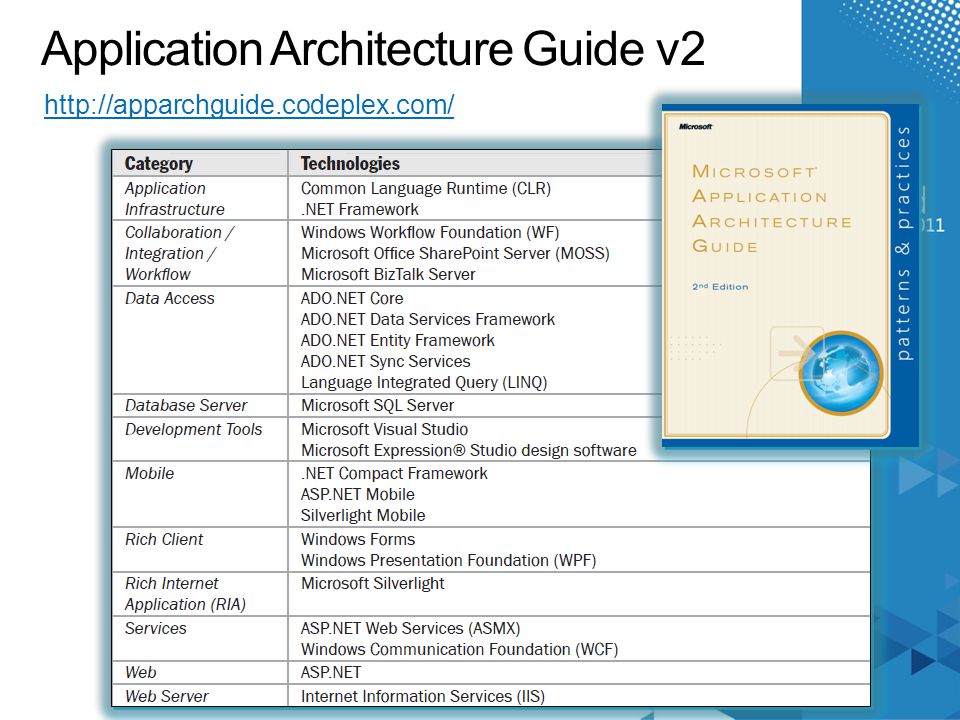-
Microsoft Application Architecture Guide카테고리 없음 2021. 2. 23. 01:53
Latitude d830 windows 7 drivers. Drivers & software for Dell Latitude D830 (Latitude): Application, Audio, BIOS, Modem/Communications, Chipset, Diagnostics, Mouse, Keyboard & Input Devices, Network, Removable Storage, Serial ATA, Change Management Software Development Kit, Systems Management, Security, System Utilities, Video for Windows XP; Windows 2000; Windows Vista, 64-bit; Windows Vista, 32-bit; BIOS; Windows XP, 64-bit; Windows 7, 64-bit; Windows 7, 32-bit; Windows XP Embedded; Red Hat Ent Linux 3; Red Hat Ent Linux 4; Windows Server 2003.
- Microsoft Application Architecture Guide Pdf Download
- Microsoft Application Architecture Guide 2nd Edition
Now Available: Final PDF of the Microsoft Application Architecture Guide, Second Edition. This is a gr8 resource for anyone working on Microsoft platform. Over the years Micorsoft platform has evolved in many directions that made it difficult for developers to grasp every thing from architectural standpoint.
-->
This guide presents a structured approach for designing applications on Azure that are scalable, resilient, and highly available. It is based on proven practices that we have learned from customer engagements.
Introduction
The cloud is changing the way applications are designed. Instead of monoliths, applications are decomposed into smaller, decentralized services. These services communicate through APIs or by using asynchronous messaging or eventing. Applications scale horizontally, adding new instances as demand requires.
These trends bring new challenges. Application state is distributed. Operations are done in parallel and asynchronously. The system as a whole must be resilient when failures occur. Deployments must be automated and predictable. Monitoring and telemetry are critical for gaining insight into the system. The Azure Application Architecture Guide is designed to help you navigate these changes.
Traditional on-premises Modern cloud Monolithic, centralized
Design for predictable scalability
Relational database
Strong consistency
Serial and synchronized processing
Design to avoid failures (MTBF)
Occasional big updates
Manual management
Snowflake serversDecomposed, de-centralized
Design for elastic scale
Polyglot persistence (mix of storage technologies)
Eventual consistency
Parallel and asynchronous processing
Design for failure (MTTR)
Frequent small updates
Automated self-management
Immutable infrastructureThis guide is intended for application architects, developers, and operations teams. It's not a how-to guide for using individual Azure services. After reading this guide, you will understand the architectural patterns and best practices to apply when building on the Azure cloud platform.
How this guide is structured
The Azure Application Architecture Guide is organized as a series of steps, from the architecture and design to implementation. For each step, there is supporting guidance that will help you with the design of your application architecture.
Architecture styles
The first decision point is the most fundamental. What kind of architecture are you building? It might be a microservices architecture, a more traditional N-tier application, or a big data solution. We have identified several distinct architecture styles. There are benefits and challenges to each.
Learn more:
Technology choices
Two technology choices should be decided early on, because they affect the entire architecture. These are the choice of compute service and data stores. Compute refers to the hosting model for the computing resources that your applications runs on. Data stores includes databases but also storage for message queues, caches, logs, and anything else that an application might persist to storage.
Learn more:

Design principles
We have identified ten high-level design principles that will make your application more scalable, resilient, and manageable. These design principles apply to any architecture styles. Throughout the design process, keep these ten high-level design principles in mind. Then consider the set of best practices for specific aspects of the architecture, such as auto-scaling, caching, data partitioning, API design, and others.
Learn more:
https://reradisde.tistory.com/6. Kentucky Educational Television.
Quality pillars
A successful cloud application will focus on five pillars of software quality: Scalability, availability, resiliency, management, and security. Use our design review checklists to review your architecture according to these quality pillars.
More learning
Microsoft Application Architecture Guide Pdf Download
For a guided introduction to common cloud computing services, benefits of cloud computing, and cloud deployment modules, review Cloud Concepts - Principles of Cloud Computing.
Microsoft Application Architecture Guide 2nd Edition
For a more technical perspective on the key pillars of a cloud solution and principles for creating a solid architectural foundation, review Pillars of a great Azure Architecture.